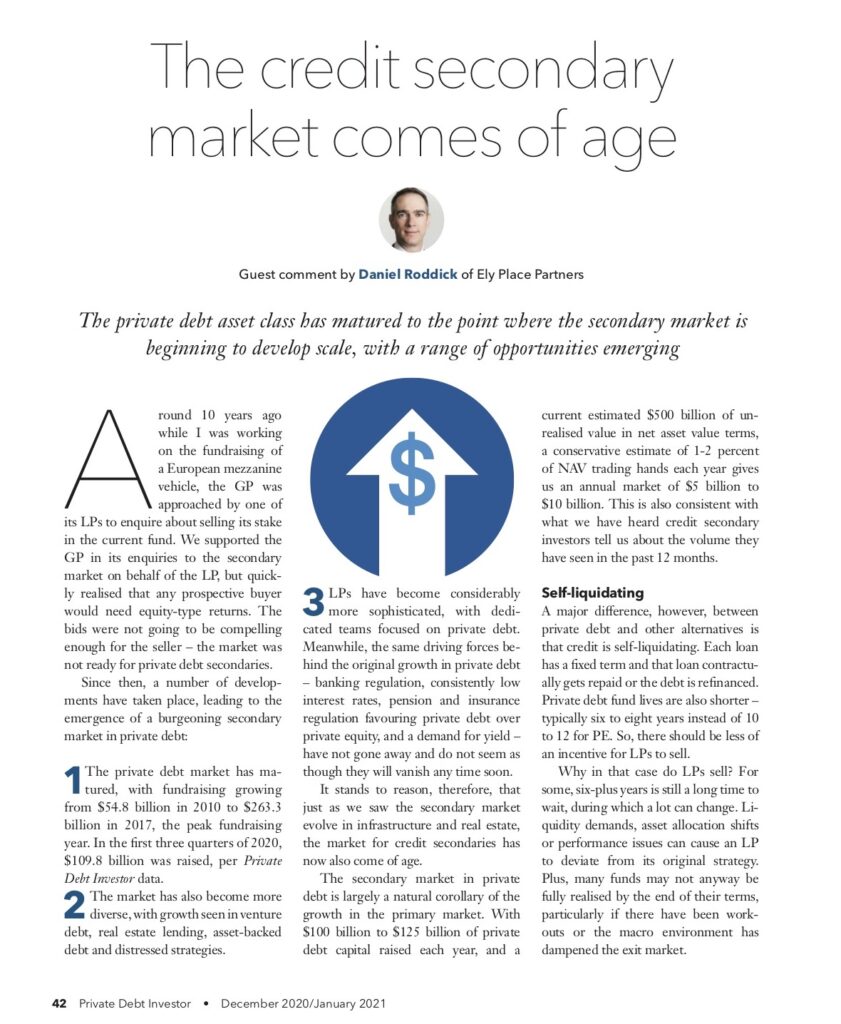The credit secondary market comes of age.
Private Debt Investor
Daniel Roddick
December 2020/ January 2021
Around 10 years ago while I was working on the fundraising of a European mezzanine vehicle, the GP was approached by one of its LPs to enquire about selling its stake in the current fund. We supported the GP in its enquiries to the secondary market on behalf of the LP but quickly realised that any prospective buyer would need equity-type returns. The bids were not going to be compelling enough for the seller – the market was not ready for private debt secondaries.
Since then, a number of developments have taken place, leading to the emergence of a burgeoning secondary market in private debt:
1. The private debt market has matured, with fundraising growing from $54.8 billion in 2010 to $263.3 billion in 2017, the peak fundraising year. In the first three quarters of 2020, $109.8 billion was raised, per Private Debt Investor data.
2. The market has also become more diverse, with growth seen in venture debt, real estate lending, asset-backed debt and distressed strategies.
3. LPs have become considerably more sophisticated, with dedicated teams focused on private debt. Meanwhile, the same driving forces be- hind the original growth in private debt – banking regulation, consistently low-interest rates, pension and insurance regulation favouring private debt over private equity, and a demand for yield – have not gone away and do not seem as though they will vanish any time soon.
It stands to reason, therefore, that just as we saw the secondary market evolve in infrastructure and real estate, the market for credit secondaries has now also come of age.
The secondary market in private debt is largely a natural corollary of the growth in the primary market. With $100 billion to $125 billion of private debt capital raised each year, and a current estimated $500 billion of un- realised value in net asset value terms, a conservative estimate of 1-2 percent of NAV trading hands each year gives us an annual market of $5 billion to $10 billion. This is also consistent with what we have heard credit secondary investors tell us about the volume they have seen in the past 12 months.
Self-liquidating
A major difference, however, between private debt and other alternatives is that credit is self-liquidating. Each loan has a fixed term and that loan contractually gets repaid or the debt is refinanced. Private debt fund lives are also shorter – typically six to eight years instead of 10 to 12 for PE. So, there should be less of an incentive for LPs to sell.
Why in that case do LPs sell? For some, six-plus years is still a long time to wait, during which a lot can change. Liquidity demands, asset allocation shifts or performance issues can cause an LP to deviate from its original strategy. Plus, many funds may not anyway be fully realised by the end of their terms, particularly if there have been work-outs or the macro environment has dampened the exit market.
So what do we expect to see? One of the effects of covid-19 will be to extend the duration of many private debt funds as companies are restructured and loans worked out. The resulting impact is sure to be a longer hold period on average for private debt funds and a greater supply of such funds on the secondary market.
On the buy side, there are currently a handful of firms that have, or are in the process of raising, dedicated pools of capital focused on credit secondaries. But we have now seen myriad different institutions participating in credit secondaries on an opportunistic basis. These include private debt funds of funds with allocations for secondaries, insurance or pension funds investing out of primary allocations and mainstream secondary firms using leverage to hit return targets. We, therefore, expect to see these institutions setting up formal allocations to private debt secondaries, as well as more funds of funds and other private equity secondary players raising dedicated pools of capital.
We have long worked with GPs on the PE side to use the secondary market in such transactions as extension vehicles, tender offers, stapled secondaries, fund re-openings and co-invest deals. This is also what we are seeing on the credit side with GPs taking advantage of the maturity in the private debt secondary market to manage their LP base, secure additional capital to support portfolios and to raise new commitments. When one of our private debt clients’ cornerstone investors sold its stake for strategic reasons, the GP was able to bring in eight more LPs via the secondary market, enhancing its LP base and positioning itself well for the next raise. We are also working with private debt GPs to bring in credit secondary investors into the final closes of our clients’ funds. If the fund is heavily drawn, such that the investor can diligence the assets, and if there is a small effective discount (by virtue of the write-up in the portfolio), it can provide a similar risk-return profile to a credit secondary.
Synthetic deals
Bespoke portfolios of co-investments for investors are another way through which we are capitalising on the private debt secondary market to raise capital for GPs. Depending on the size of the vehicle, leverage can be added to enhance returns. While not technically a secondary since there is no sale by one LP to another, our clients are creating synthetic deals that provide the desired characteristics for secondary investors.
Finally, we see opportunities for private debt GPs to use the secondary market as their funds mature and need restructuring. For instance, older funds with a few remaining assets can be uneconomical to run, particularly with leverage to pay down. Secondary investors can work with GPs to roll the assets into a larger vehicle with additional capital for new deals, thereby extending the term and bring in fresh leverage, re-incentivising the GP. This can offer exist- ing investors the option to roll into the new vehicle or sell at the restructuring.
We have come a long way since our first foray into the credit secondary market a decade ago. But, like many others, we believe this is a market where most of the growth is still to come. Taking Pantheon’s estimates that the private debt market will hit around $1.5 trillion in the next five years, with an annual secondary volume of $14 billion per annum, it will be interesting to look back to see how the market has evolved in another 10 years.



